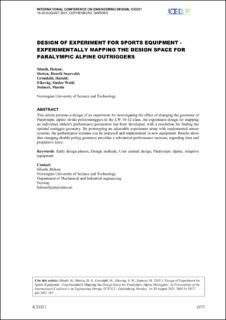| dc.contributor.author | Silseth, Helene | |
| dc.contributor.author | Sletten, Henrik Snarvold | |
| dc.contributor.author | Grøndahl, Harald | |
| dc.contributor.author | Eikevåg, Sindre Wold | |
| dc.contributor.author | Steinert, Martin | |
| dc.date.accessioned | 2021-10-28T11:20:55Z | |
| dc.date.available | 2021-10-28T11:20:55Z | |
| dc.date.created | 2021-08-20T14:05:43Z | |
| dc.date.issued | 2021 | |
| dc.identifier.issn | 2732-527X | |
| dc.identifier.uri | https://hdl.handle.net/11250/2826286 | |
| dc.description.abstract | This article presents a design of an experiment for investigating the effect of changing the geometry of Paralympic alpine sit-ski poles/outriggers in the LW 10-12 class. An experiment design for mapping an individual athlete’s performance parameters has been developed, with a resolution for finding the optimal outrigger geometry. By prototyping an adjustable experiment setup with implemented sensor systems, the performance increase can be analysed and implemented in new equipment. Results show that changing double poling geometry provides a substantial performance increase, regarding time and propulsive force. | en_US |
| dc.language.iso | eng | en_US |
| dc.publisher | Cambridge University Press | en_US |
| dc.rights | Attribution-NonCommercial-NoDerivatives 4.0 Internasjonal | * |
| dc.rights.uri | http://creativecommons.org/licenses/by-nc-nd/4.0/deed.no | * |
| dc.title | Design of experiment for sports equipment - experimentally mapping the design space for paralympic alpine outriggers | en_US |
| dc.type | Journal article | en_US |
| dc.description.version | publishedVersion | en_US |
| dc.source.journal | Proceedings of the Design Society | en_US |
| dc.identifier.doi | 10.1017/pds.2021.107 | |
| dc.identifier.cristin | 1927696 | |
| cristin.ispublished | true | |
| cristin.fulltext | original | |

